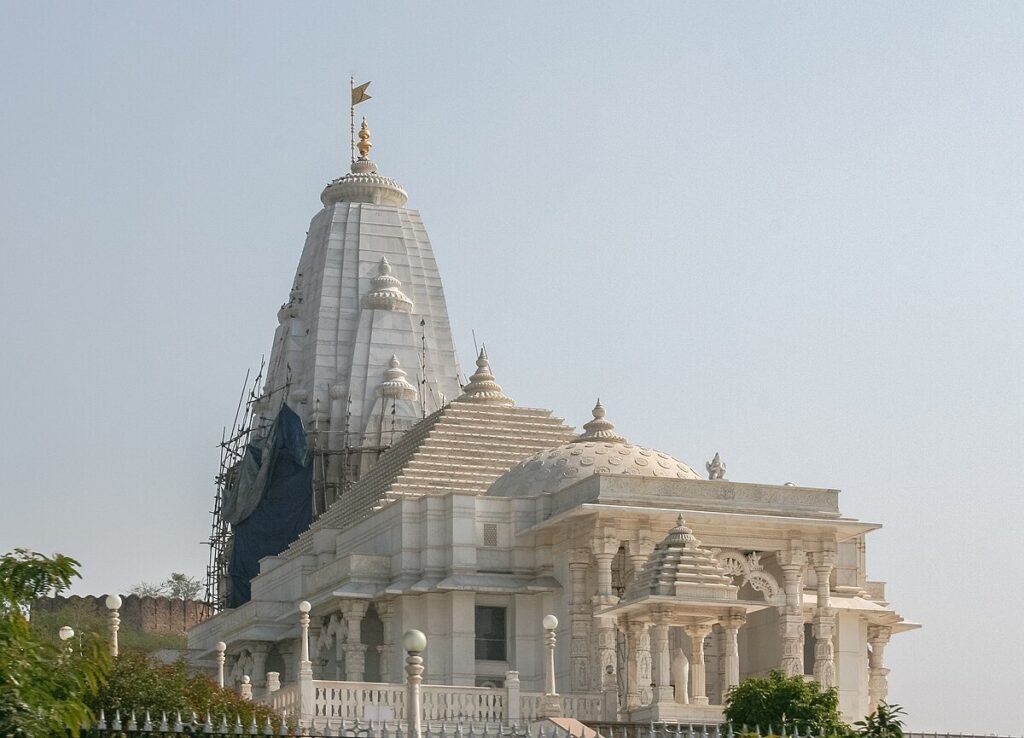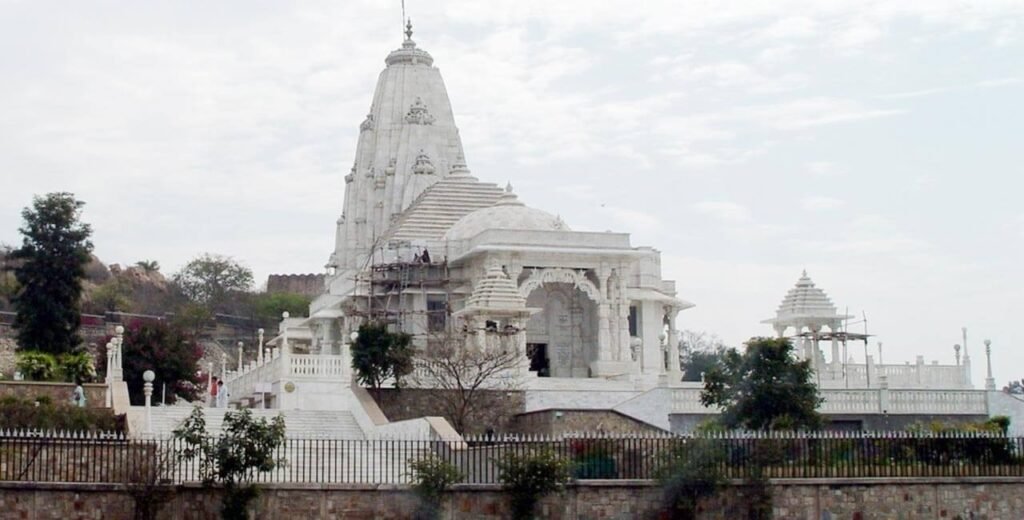Set against the picturesque backdrop of Moti Dungri Hill, the Birla Mandir in Jaipur stands as a testament to devotion, architectural artistry, and India’s rich cultural heritage. Revered as the Lakshmi Narayan Temple, this dazzling white marble marvel is not only a prominent religious landmark but also a symbol of Jaipur’s vibrant culture and heritage.
History of Birla Mandir
The story of Birla Mandir is one of philanthropy, inclusivity, and devotion. The land, spanning nearly 1.5 acres, was sold by Jaipur’s Maharaja to the Birla family for a token sum of just ₹1, symbolising faith over fortune. The foundation stone was laid in 1977, and under the patronage of the B. M. Birla Foundation, the construction spanned more than eight years. The temple was completed and consecrated on 22nd February 1985.
A unique historical footnote: Mahatma Gandhi was invited to inaugurate the temple. He agreed only on the condition that the temple welcome devotees of all castes and backgrounds, fostering a tradition of equality and open worship that’s continued to this day.
Key Details:
Architectural Brilliance
The Birla Mandir is a masterpiece, entirely crafted from gleaming white marble sourced from Makrana, which seamlessly blends modern design with traditional Hindu temple motifs.
- Three Domes: Represent three principal faiths in India, symbolising cultural harmony.
- Sculptures and Carvings: The temple features exquisite carvings of stories from the Gita and Upanishads, as well as symbols from Hindu mythology, and inscriptions of ancient texts on its walls.
- Stained Glass Windows: These windows uniquely depict legends from Hindu scriptures, imbuing the interiors with a mystical ambience during daylight hours.
- Inclusivity in Sculpture: While the inner sanctum venerates Lakshmi and Narayan (Vishnu), the external walls also honour figures like Buddha, Socrates, Confucius, Christ, and the Virgin Mary, reflecting the ethos of universal spirituality.
- Gardens and Museum: Lush gardens surround the temple, providing allure and tranquillity. Below the main structure is the Birla Family Museum and the G. P. Birla Gallery, showcasing priceless photographs, relics, and the philanthropic legacy of the Birla family.
Festivals and Celebrations
Birla Mandir is particularly enchanting during Indian festival seasons:
- Janmashtami: Celebrated with great pomp to honour Lord Krishna’s birth, the temple is adorned with thousands of lights and floral decorations. Special prayer sessions and devotional music draw crowds from across the nation.
- Diwali: The temple and its campus dazzle with illuminated lamps, vibrant rangolis, and festive rituals, making it a sight to behold in Jaipur’s festival calendar.
Location and Route
Birla Mandir is strategically located in the heart of Jaipur’s Tilak Nagar, at Jawahar Lal Nehru Marg, beneath the famous Moti Dungri Fort. This makes it accessible from all corners of the Pink City. The temple is about 6 km from Jaipur Junction Railway Station and roughly 11-12 km from the Jaipur International Airport. Visitors can use buses, taxis, or auto-rickshaws to reach this iconic spot, with city buses making frequent stops near the temple.
- Address: Jawahar Lal Nehru Marg, Tilak Nagar, Jaipur, Rajasthan 302022
- Reaching By Car/Taxi: 6-7 km from the city centre; 15-20 minutes from the airport
- Bus Option: Regular buses ply from Jaipur Station to Rambagh Circle, a short distance from the temple. Tickets cost ₹26–₹ 40, and the journey takes approximately 19 minutes.
Visiting Details
- Timings:
- Entry Fee: Free for all visitors
- Photography: Not allowed inside the temple’s inner sanctum for preservation and spiritual sanctity.
- Best Time to Visit: October to March for comfortable weather and memorable celebrations, especially during major Hindu festivals and sunset hours when the marble gleams.
Cultural and Social Significance
Birla Mandir’s greatest legacy is its spirit of inclusion and service. Visitors from all backgrounds are welcome without discrimination. The temple has also been pivotal in sustaining Jaipur’s spiritual traditions while embodying modern values of unity and respect.
Its presence near Moti Dungri Fort and its gleaming nighttime image have also made the temple an icon in Jaipur’s skyline, reinforcing the city’s reputation as a confluence of old and new.

Revenue and Local Economy
While entry remains free to all, Birla Mandir draws thousands of tourists and pilgrims daily, substantially impacting Jaipur’s tourism sector. Although direct revenue figures are not officially published, the temple’s consistent influx of tourists indirectly supports hundreds of local vendors, guides, transportation providers, and the hospitality sector as a whole. The attached museum and gift shop make a moderate contribution to temple maintenance and heritage activities.
Must-See Attractions Near Birla Mandir
- Moti Dungri Fort: A short walk from the temple, known for its unique architecture and panoramic city views.
- Albert Hall Museum: Jaipur’s oldest museum, a treasure trove of art and history.
- Rambagh Palace: Living testament to Jaipur’s royal heritage.
FAQs About Birla Mandir, Jaipur
What is Birla Mandir famous for?
Birla Mandir is renowned for its stunning white marble architecture, intricate carvings, and its unique blend of inclusivity, welcoming worshippers from all castes and faiths.
How can one reach Birla Mandir from the railway station or airport?
The temple is about 6 km from Jaipur Junction and 11-12 km from Jaipur International Airport. Visitors can take a taxi, bus, or auto-rickshaw; the nearest bus stop is Rambagh Circle.
Are there any entry fees or restrictions?
Entry is free for all visitors; however, photography is not allowed inside the temple’s inner sanctum. The temple’s welcoming spirit extends to all, regardless of background or faith.
Which deities are worshipped at the temple?
The temple is devoted to Lord Vishnu (Narayan) and Goddess Lakshmi. Idols are sculpted from a single piece of marble, with other deities, such as Ganesh, also depicted.
What are the timings and the best time to visit?
Birla Mandir is open daily from 6:00 AM to 12:00 PM and 3:00 PM to 9:00 PM. October to March is the best time for a visit, though festival times are especially magical.
Can foreigners and tourists of all religions visit the temple?
Yes, the temple’s very foundation is rooted in inclusivity and openness to visitors of all backgrounds and faiths.
Are there facilities for people with disabilities?
Birla Mandir offers ramps and assistance to facilitate easy access, making it a welcoming site for all age groups and physical abilities.
What makes the temple unique in Jaipur’s temple circuit?
Unlike many historical temples, Birla Mandir fuses modern architecture with traditional elements, stands for inclusivity, and shines as a symbol of peace on Jaipur’s skyline.
